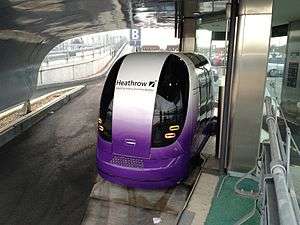Catapult centres
Catapult centres are organisations set up from 2011 onwards by Innovate UK (previously the Technology Strategy Board) in the United Kingdom to promote research and development through business-led collaboration between scientists and engineers to exploit market opportunities.[1][2][3] They receive grants from public funds but are also expected to seek commercial funding.
History
In 2010, the Department for Business, Innovation and Skills commissioned a report into technical innovation from Hermann Hauser, an entrepreneur who had been active in information technology since 1978. The report recommended the establishment of a number of Technology and Innovation Centres.[4][5]
Each centre received "core" funding of £10 million per year for five years, via Innovate UK. It was intended that the long-term split would be one-third core funding, one-third commercial funding, and one-third collaborative (public and private) research & development funding.[6]
Centres


The current centres, with their operational dates and locations, are as follows.[6]
- Cell & Gene Therapy – October 2012 – at Guy's Hospital, London
- Digital – June 2013 – in Kings Cross, London. Projects include
- Future Cities – June 2013 – in Clerkenwell, London
- High Value Manufacturing – October 2011 – seven Technology and Innovation centres working with companies of all sizes to bridge the gap in, and accelerate the activity between, technology concept and commercialisation.[7] These include:
- The Centre for Process Innovation – at Redcar, North Yorkshire
- The National Composites Centre – at the Bristol and Bath Science Park
- Warwick Manufacturing Group – at the University of Warwick
- Offshore Renewable Energy – March 2013 – wind, wave and tidal power – in Glasgow
- The National Renewable Energy Centre (Narec) at Blyth, Northumberland merged with ORE in 2014[8]
- Satellite Applications – December 2012 – at Harwell Science and Innovation Campus, Oxfordshire
- Transport Systems – August 2013 – in Milton Keynes
- Energy Systems – April 2015 – in Birmingham
- Medicines Discovery – July 2015 – at Alderley Park, Cheshire; absorbed former Precision Medicines Catapult in 2017[9]
- Compound Semiconductor Applications – 2016 – in Cardiff[10]
2017 report
In view of the completion of the five-year funding periods for the first centres, the Department for Business, Energy and Industrial Strategy commissioned a report from Ernst & Young which was published in November 2017.[6]
The report found that approximately £1.25 billion had been received by the centres, of which about £745 million came from the public sector. Only the High Value Manufacturing Catapult had achieved its funding targets, with the others heavily reliant on public funding. The report criticised the strategies, governance and performance management of most of the centres, and made 38 recommendations. Three centres – Digital, Future Cities and Transport Systems – were identitied as in need of remedial plans, with the possibility of halting their further funding.[11]
2018 funding
In August 2018, the government announced funding totalling £780 million to be provided to several of the centres,[12] over the next five years.[13]
References
- ↑ "Plan to 'Catapult' UK space tech". BBC News.
- ↑ "London's Digital Catapult Centre will open in November to inspire SMBs". The Enquirer.
- ↑ Inman, Phillip (4 March 2014). "We will help to expand skill centres, Labour tells industry". The Guardian. Retrieved 2 December 2017.
- ↑ "Government backs Hauser proposal on technology and innovation centres". coi.gov.uk. 25 March 2010. Archived from the original on 3 April 2010.
- ↑ Hauser, Hermann (March 2010). "The Current and Future Role of Technology and Innovation Centres in the UK". National Archives. Retrieved 2 December 2017.
- 1 2 3 Ernst & Young (17 November 2017). "Catapult Network Review" (PDF). GOV.UK. Retrieved 2 December 2017.
- ↑ "7 HVM Catapults". Catapult.
- ↑ Gibson, Robert (4 April 2014). "Narec to merge with Glasgow's Offshore Renewable Energy Catapult". journallive. Retrieved 27 August 2018.
- ↑ "Additional responsibilities for Medicines Discovery Catapult". GOV.UK. 26 June 2017. Retrieved 20 August 2017.
- ↑ "Compound semiconductors: new Catapult centre in Wales". GOV.UK. 8 January 2016. Retrieved 20 August 2017.
- ↑ Orlowski, Andrew (28 November 2017). "Three useless UK.gov 'catapults' put in Last Chance Saloon". The Register. Retrieved 2 December 2017.
- ↑ "Chancellor announces funding for Catapult network". UK Research and Innovation. 10 August 2018. Retrieved 26 August 2018.
- ↑ "Five-year funding confirmed for University's High Value Manufacturing Catapult centres". The University of Sheffield. 10 August 2018. Retrieved 26 August 2018.